How do I choose seed beads?
If you’re anything like me, then as a beginner, one of the first things you’ll notice is the overwhelming variety of beads available. So, you’ve probably found yourself asking, ‘how do I choose seed beads from all this variety?’
Well, I have good news. If you are working from a pattern, the designer should have told you which beads to use. So, go with that.
However, that might still leave you questioning things if you want to use different colours. So, let’s get a little more specific here. I’m going to deal with the different brands of beads in another blog. For now, let’s take a look at the question of the choices of bead finish.
What are the problems you will encounter?
Seed beads come not just in different colours, but also in different finishes. In some ways it’s a little false to separate the colour from the finish as it is very often the type of finish that creates a particular shade of colour.
When I first started beading, I found it very difficult to understand what these finishes meant. I could make a guess at silver-lined, but what was an AB finish? I also made the mistake of ordering some beads labelled as ‘iris’ to make an Iris flower. Now, I didn’t realise that the ‘iris’ in this context had very little to do with flower colours. So the beads that arrived weren’t really quite what I had in mind for the planned flower! No wonder I found myself asking again and again, ‘how do I choose seed beads with success?’
Something else that I have learned over time, through experience, is that the colour of beads can actually affect their size. We’re only talking about a fraction of a millimetre. But if you’re using the beads ‘en masse’ this can add up to a significant difference. I’m not going to talk about that in this blog. However, if you do want to know more about how seed bead sizes vary, then this blog is a must-read.
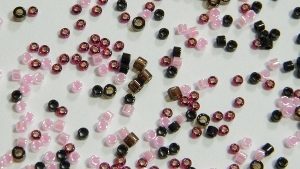
Advice when shopping
Unfortunately it’s difficult to convey colour and finish accurately through photos. This is especially true online where different computer screens may render the colours a little differently.
This is a good lesson to learn early on. If you’re ordering seed beads online (and unless you live next door to a bead shop, you almost certainly will end up doing this), be prepared for a few surprises!
If you really need a colour to match an outfit or something else, then I recommend looking at the beads for real, not just on a screen. But then the same advice applies to buying a new outfit. Someone else’s description of a colour may not match your ideas about the colour.
If it’s possible to order a small quantity or a sample so you can get a sense of colour, then this is a great idea. And, if you are using Miyuki seed beads or Delicas, the Miyuki company offers colour charts giving little samples of each bead colour/finish. You can ask your local bead store if they sell these colour charts.
Common seed bead finishes
Having made that caveat, let’s take a look at the most common bead finishes. The photo above shows three different shades of green seed beads. The shading has a lot to do with the bead finish.
Focus on the beads on the needle: the left hand bead looks a lot darker than the others. It is a darker shade of green, but it also has an opaque finish. This means that it doesn’t let light through, so it will appear darker. You can have opaque, like this, which still has a bit of a sheen to it, or ‘matte’ which is really dull and lacklustre.
The middle bead has a transparent finish. This means that light will shine all the way through it, so it immediately appears a little lighter, whatever shade you are using.
The right hand bead has a silver-lined finish. Quite literally, the inside of the bead has been ‘lined’ with silver. This makes it really sparkle, or reflect light, so it will appear lighter than its identical colour with a matte or opaque finish.
Colour Lined Beads
You will also find ‘colour lined’ seed beads. This is the same principle as silver lined – the inner hole has been coated with a colour that is different from the glass colour of the bead. In the photo below, you can just about make out the silver lining in the green bead. If you look carefully, you may also be able to see that the purple beads are in fact made from blue transparent glass that has been coated internally with a pink/purple shade. This lining can create interesting effects, but be warned, it is less durable than a matte or opaque, or even transparent bead. As with any other coat of paint, it is liable to damage or wear off over time.
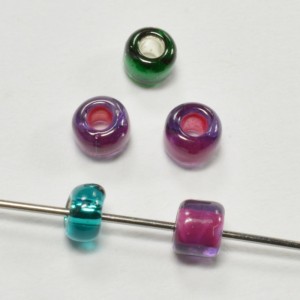
AB, Iris and Ceylon Finishes
So, back to those AB seed beads…AB stands for ‘Aurora Borealis’ and, like the natural lights from which the name is taken, it means that the beads contain a range of different shading. This may not notice so much in a single bead, although it can still be noticeable, depending on the colour, but it will be more obvious when you see the seed beads in a large group. Take a look at the turquoise beads in the photo below. You can use this finish to create easy natural shading. But it can also be a problem if you are wanting a very ‘true’ or dense patch of colour. So bear this in mind if you are choosing AB finishes.
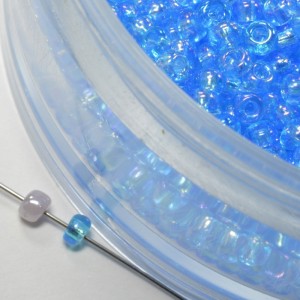
The iris finish is similar: it is basically iridescent – like a dragonfly wing. So as the bead catches the light, you will be more or less aware of different shades of colour within that bead.
The other main finish is ‘ceylon’. This is basically a pearlised finish – indeed, it can be referred to as ‘pearl’ finish. This finish is usually applied to the paler shades in the colour palette. So the effect is very delicate and elegant, rather like pearls. It has a very true colour and the finish seems to last well. But be warned, the colour appears more dense when you see a lot of these beads in a tube together than it will seem when you are using single beads. The pale blue bead in the photo above is a sample of a Ceylon finish.
Metallic Finishes
Seed beads with metallic finishes are always a problem. Unless you have a small fortune to spend on sterling silver beads, it is difficult to find beads that will look like metal, but also wear well.
Silver lined gold or silver lined crystal can appear as gold or silver, but over time the inside lining does discolour a little. You will see a lot of metal ‘coated’ beads. Again, these look good at first, but the coating tends to wear off and discolour as it comes into contact with the skin.
In fact, if you are buying any beads that talk about having a ‘coated’ finish, take great care. I have had those coated finishes rub off on my skin, leaving the beads rather unattractive and me with a semi-permanent necklace or bracelet! So, how do I choose seed beads if I want a metal look?
I have found that the best metal finish is ‘Duracoat’. The coating on these beads is excellent and, alongside a range of colours, they offer some metal finishes. In the photo below, I have shown the detail of a necklace I made using Duracoat Delicas – just click this link to get the tutorial.
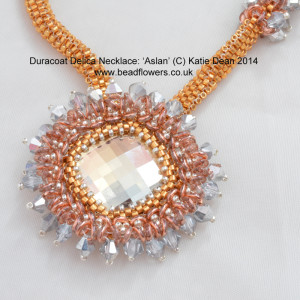
You can also try the galvanised finishes. I have found the Miyuki brand wears well and seem to both look metallic and hold their colour over time. But if your skin chemistry is different to mine, you may not agree with me.
How do I choose seed beads?
So, let me finish with a few tips that I have learned over time. Hopefully you will now be better placed to answer that question…how do I choose seed beads with such a huge variety available?
Firstly, the more beading you do, the more you will get to understand what the different finishes mean. And you will start to observe how they interact with one another. So, as you start, try as many different types as you can!
Secondly, and linked to that, learn all you can. So, a blog post like this will help you learn more about what is available. You can use that knowledge to guide you to make your choices.
Thirdly, it’s worth looking at colour theory. In particular, this blog post about how light interacts with seed bead finishes will help you understand more.
Hopefully this has given you a basic guide so you don’t get too many complete shocks from all that online shopping!


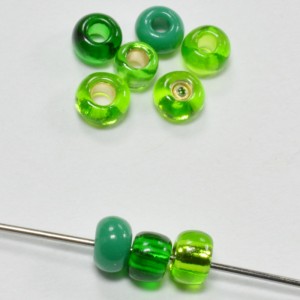
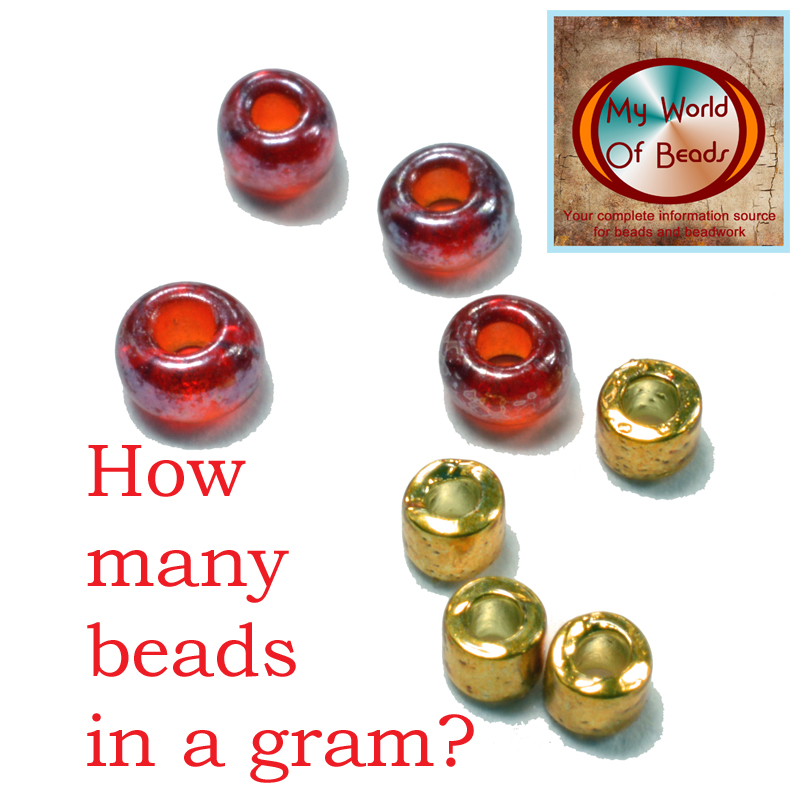

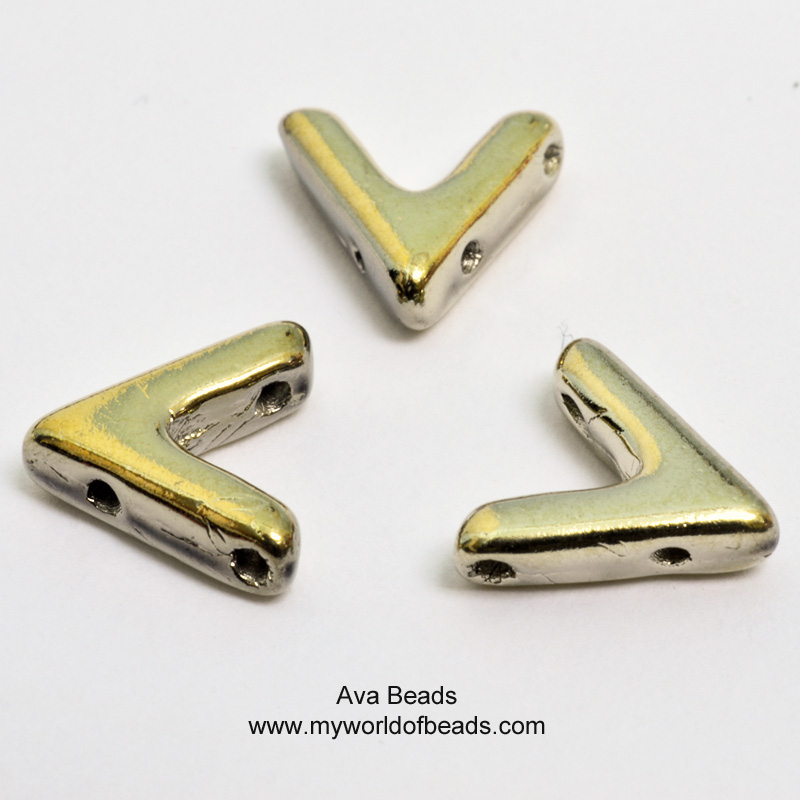






Thankyou for posting this it really has helped me with that dreaded dilemma of ” which seed beads should I buy ” I have been jewellery making for a few years now but I have just started with the bead weaving journey which has proved to be nothing but questions, what loom, what cord/thread, what beads, it’s never ending WHATS lol, I am looking forward to reading more of your blogs now .
I’m really happy that this has helped you. I still remember those days of never-ending ‘what’ questions! The good news is, as you gain experience, you also gain answers for yourself. And my biggest piece of advice to help with this is: never be afraid to just try things out. Don’t feel afraid of doing things differently, or even discovering the things that don’t work for you. I hope you have a wonderful time exploring and creating your own beautiful pieces of beadwork!